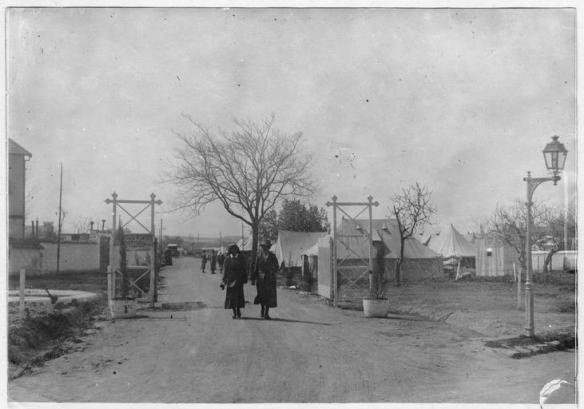While the British War office did not accept Dr Inglis’s offer, other allied governments did. France was one of them. Following the positive experience with the first SWH in France (Abbaye de Royaumont), the French government requested an additional hospital which was installed in May 1915 in the town of Troyes, in Champagne, with Dr Louise McIlroy as Chief Medical Officer. It was called the Girton and Newnham (G&N) Unit because most of the funding came from the alumni of the two women’s colleges in the University of Cambridge. When the decision was made to send French troops to Salonika, G&N accompanied them: first in Guevgueli, in October 1915, when the French tried to assist the Serbian army in the Vardar valley and in December of the same year, in Thessaloniki. This unit stayed always under the French medical authorities of Thassaloniki. The designated site was east of the city, in a vast area with many French field hospitals near the Allatini Mills. A French croquis of the area indicates that the G&N was close to the sea, next to the 4th French hospital.
Two photos with the distance of a century. French Temporary hospital No 4 in green, the SWH G&N in red; A Ascension church, K Kapandji villa, X1 Hadjilazaro Pericles villa; X2 Hadjilazaro kleon villa, H Hirsch villa, Σ Seyboulah pacha villa; Kapandji villa was the headquarters of Venizelos government from early October 1916 to mid June 1917. With the arrow the place of Hadjilazaro Nicolas villa.


Doctors and nurses of the hospital in Salonika

According to the C.M.O, in the summer of 1916 the heat in Macedonia was excessive, and the armies suffered a lot from malaria and dysentery. The hospitals of the area were full to overflowing, and the Scottish Hospital, extended its beds to 300. During June, July, and August, patients were pouring in, while others were being evacuated on to the hospital ships to be taken to France.
The entrance to the hospital

Dr McIlroy in an article published in 1917 wrote: “Much credit is due to the French and British Army Medical Services in Salonica for the magnificent way in which they handled the unexpected epidemic of sickness which spread through the troops in Macedonia. Those at home were not given the opportunity of knowing how great was the strain, and how colossal were the difficulties which had to be contended with”.
Sunbathing of patients (photo taken by Joseph Pigassou medical officer of the nearby No 4 French Temporary hospital)

In autumn 1916 an advance of allied troops took place across the front, and wounded began to pour into the hospital. During winter and spring of the following year the hospital was full of surgical cases of “very great interest”. Dr McIlroy modestly wrote: “The main success of the hospital has been due to the work of the assistant surgeons, Dr. Honoria Kerr, Dr. Barbara Macgregor, Dr. Mary Alexander, Dr. Mary M’Neill ; to Dr. Isobel Emslie, bacteriologist ; and to Miss Edith Stoney, radiologist. Much is due to the nursing staff for their skill and care in looking after the sick and wounded so whole-heartedly entrusted to us by the French War Office”.

The last photo you present was taken by Joseph Pigassou medical officer at the Temporary Hospital n4 ! Thank you to mention it !
LikeLike
Thank you very much for this information!
LikeLike
Pingback: Le Grand Parc Aéronautique des Armées d’Orient – The Great Aeronautical Park of the Salonika Armies | Little stories of big History
Little mistake : The installation at Château de Chanteloup, Sainte-Savine, near Troyes, was in May 1915, not in 1916.
Thank you for your article.
(more information : https://fr.wikipedia.org/wiki/Scottish_Women's_Hospitals)
LikeLike
Pingback: The Scottish Women’s Hospitals: The Elsie Inglis Unit | Little stories of big History
Pingback: The Scottish Women’s Hospitals – The American Unit | Little stories of big History
Pingback: Τα Νοσοκομεία Σκωτσέζων Γυναικών (ΝΣΓ) σε Θεσσαλονίκη και Έδεσσα (1915 – 1918) | Little stories of big History